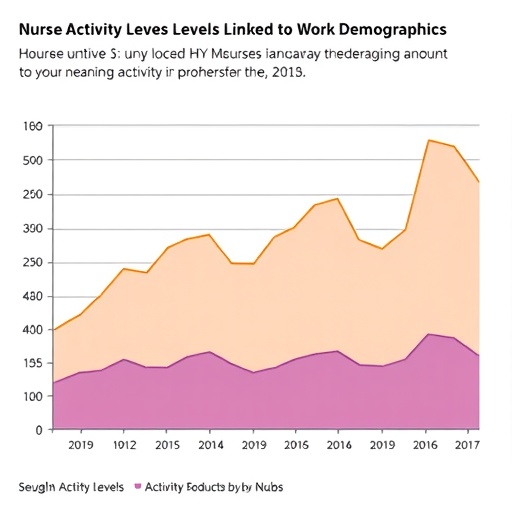In an era marked by an increasing emphasis on healthcare professionals’ well-being, a recent study sheds light on critical aspects impacting nurses in emergency and outpatient settings. The research scrutinizes the intricate interplay between physical activity levels and various work-related demographic factors that characterize the lives of these vital healthcare workers. Conducted with methodological rigor, this cross-sectional correlational study stands as a beacon for future explorations into the health patterns influencing nursing professionals, whose roles are paramount during times of crisis.
At the core of this investigation lies the pressing question: how does one’s level of physical activity interact with demographic factors such as age, gender, experience, and work environment? The significance of understanding this relationship cannot be overstated, as it not only informs personal health strategies for nurses but also guides institutional policies aimed at enhancing workplace wellness. The researchers have adopted a comprehensive approach, employing quantitative methods to gather and analyze data that illuminates these often-overlooked dimensions of nursing practice.
Emerging from the findings, the analysis reveals a complex landscape where physical activity levels are markedly influenced by demographic characteristics. Nurses in the study who reported a higher engagement in physical activities correlated positively with several demographic attributes, such as age and type of nursing role. These revelations suggest that age, often perceived as a hindrance to physical activity, may paradoxically enhance certain aspects of lifestyle choices for nurses engaged in demanding environments. The nuances of these relationships require further examination to disentangle the various threads of influence that connect physical health to demographic markers.
Intriguingly, the research highlights how the work environment plays a crucial role in shaping physical activity patterns among nurses. Emergency and outpatient settings, with their unique demands and organizational cultures, create distinct challenges and opportunities for physical engagement. Nurses working in fast-paced, high-stress conditions often face barriers to regular physical activity, which can adversely affect their health and job performance. Understanding these environmental factors is crucial for designing interventions aimed at fostering healthier lifestyles within these critical roles.
The implications of this study extend beyond individual well-being; they resonate across entire healthcare systems. With nurses playing a pivotal role in patient care, maintaining their physical health is paramount not only for their longevity in the profession but also for the quality of care they provide. By highlighting the relationship between demographic factors and physical activity, this research calls for a holistic approach to nurse wellness programs, emphasizing support systems that encourage staff to integrate physical activity into their daily routines.
Furthermore, the study draws attention to the need for targeted training and resources tailored to different demographic groups within nursing. For instance, younger nurses might benefit from educational workshops focusing on the importance of physical activity right from the onset of their careers, while more seasoned professionals could leverage mentorship programs that encourage physical engagement amidst their demanding schedules. Such stratified approaches could optimize the benefits derived from physical activity across various age groups and professional experiences.
The researchers also urge healthcare administrators to recognize the substantial economic implications of supporting nurse health through increased physical activity. A healthier nursing workforce can lead to reduced absenteeism, lower healthcare costs, and improved patient outcomes. By investing in wellness initiatives that promote physical activity, healthcare institutions can not only enhance the quality of life for their staff but also significantly boost their operational efficiency.
Reflecting on the findings, it becomes evident that fostering a culture of physical wellness in nursing goes hand in hand with embracing the diversities within the workforce. Tailoring strategies to meet the varied needs of nurses based on their demographic factors can be transformative. As this research illustrates, enhancing physical activity levels does not merely contribute to individual well-being; it cultivates a supportive environment where nurses can thrive professionally and personally.
Moreover, the study emphasizes the importance of continual research in this field. The healthcare landscape is ever-evolving, and as new challenges arise, the health and wellness strategies for nurses must also adapt. Future studies should focus on longitudinal approaches, examining how these relationships evolve and how interventions impact nurse welfare over time. By maintaining a proactive stance toward research, healthcare systems can ensure that they stay ahead of the curve in promoting nurse wellness.
In conclusion, this research by Fitria and colleagues provides essential insights into the factors influencing physical activity among emergency and outpatient nurses. The intricate connections between demographic variables and physical wellness underscore the need for a multifaceted approach to health promotion within nursing. As the healthcare sector continues to navigate unprecedented challenges, prioritizing the well-being of nurses through informed strategies can lead to healthier professionals, improved healthcare outcomes, and a more resilient healthcare system.
The findings serve as a rallying call for stakeholders at all levels to invest in the physical wellness of nurses. It is an opportune moment for healthcare organizations to reevaluate their policies, encouraging environments that prioritize and facilitate physical activity. This holistic understanding of nurse wellness not only promises to enhance individual nurse lives but also fortifies the very fabric of patient-centered care across the healthcare continuum.
In essence, the study is a clarion call for nurturing the physical health of an indispensable workforce—one that is vital for the future of healthcare. By championing initiatives that encourage physical activity and recognizing the diverse demographic factors at play, the healthcare industry can ultimately ensure a more sustainable and thriving nursing profession.
Subject of Research: The relationship between physical activity level and work-related demographic factors among emergency and outpatient nurses.
Article Title: Exploring the relationship between physical activity level and work-related demographic factors among emergency and outpatient nurses: a cross-sectional correlational study.
Article References: Fitria, N., Karisa, P., Manseaur, G.H. et al. Exploring the relationship between physical activity level and work-related demographic factors among emergency and outpatient nurses: a cross-sectional correlational study. BMC Nurs 24, 1159 (2025). https://doi.org/10.1186/s12912-025-03792-5
Image Credits: AI Generated
DOI:
Keywords: Physical activity, nursing, demographics, healthcare, wellness programs.




